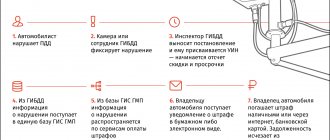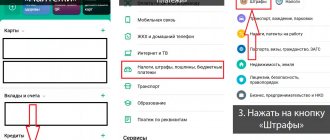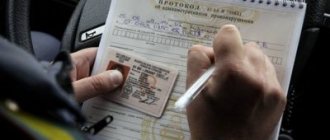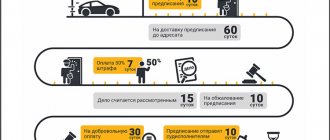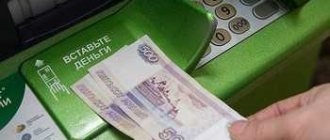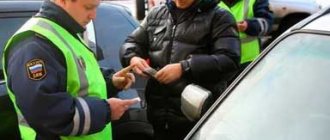The order to pay fines for violating the Traffic Rules, like any official document, has a fixed deadline for its execution.
The repayment period for traffic fines from May 9, 2013 is 60 days, which are calculated from the moment the resolution comes into force. And it comes into force immediately after the expiration of 10 days given for the possibility of appealing the fine to the State Traffic Inspectorate or court.
Today we will talk in detail about the nuances of calculating the repayment terms of administrative fines for traffic violations, point out the possibility of obtaining a deferment or installment plan for fines, and also talk about liability for their late payment.
What is the deadline for paying traffic fines?
To find out how long the law allocates for paying off fines for administrative offenses (including traffic violations), just refer to Article 32.2 of the Code of Administrative Offenses of the Russian Federation. It states that fines are paid in full within 60 days from the date of entry into force of the decision imposing an administrative fine.
When exactly does the resolution come into force? Let us turn for clarification to the full text of Article 31.1 of the Code of Administrative Offenses of the Russian Federation:
A decision in a case of an administrative offense comes into force:
1) after the expiration of the period established for appealing a decision in a case of an administrative offense, if the said decision has not been appealed or protested;
2) after the expiration of the period established for appealing a decision on a complaint, protest, if the said decision has not been appealed or protested, except in cases where the decision cancels the decision;
3) immediately after making a non-appealable decision on a complaint or protest, except in cases where the decision cancels the decision.
The driver is given exactly 10 days to appeal from the moment he receives the decision (or a copy thereof). If the decision was issued by a traffic police inspector, then the countdown of 10 days to appeal it begins immediately, that is, the next day will be the first.
If the decision came by mail (in the case where the violation was recorded by automatic traffic cameras), then the period is counted from the day it was delivered by the postman or from the day the driver received the mail notification.
Important! If you evade receiving the document, the resolution will inevitably return to the addressee (the traffic police authority) and will still come into force 10 days after the return.
As a result, we find that the time for paying the fine includes:
10 days (appeal) + 60 days (payment of fine) = 70 days (from the date of receipt of the decision)
We determine the details for transferring the payment
Payments are processed only if the payer has all the necessary details. The basis for mutual settlements is a receipt for payment of an administrative fine (if the penalty is transferred by an official) or a payment order (if the payment is made on behalf of the customer organization). Here's what you'll need to transfer money to the budget:
- TIN, KPP and OGRN of the recipient;
- name of FAS (not the name of the body, but its name and personal account in bank documents);
- bank details;
- current account number of the supervisory authority;
- BCC for a specific type of recovery;
- UIN - unique payment identification number;
- details of the basis document (resolution).
We suggest you read: Filing an application for divorce at a location other than your place of registration.
It is very easy to find out all this data. They are in the administrative document about the administrative offense. They also provide the budget classification code and the UIN.
The customer has many payment options available: through applications, a government services portal, a terminal or a bank whose client is the payer. The method of calculation depends on whose name the fine was issued.
A payment order is drawn up in case of payment of an administrative fine by a legal entity. The previous methods will not work - customers, especially public sector employees, have certain rules for reporting and budget execution. Funds are allocated for mutual settlements on collections (KOSGU 292), financing is carried out in full and is included in periodic and final reporting.
The payment order is also confirmation of the fact of payment for the Antimonopoly Service. The decision on the offense indicates how much time is given to pay the administrative fine, and what details to send the payment to. Violating payment terms and procedures is prohibited.
We are preparing a payment order.
Step 1. Determine the number and date. Numbering in payment documents is in order.
Step 2. Enter the amount of the fine according to the resolution.
Step 3. We indicate the payment details of the payer (customer) and recipient (FAS) of funds.
Step 4. We enter codes that identify the payment: transaction type 01 (field 18), unique number of each payment UIN (field 22), priority - 5 (field 21), KBK (field 104), territorial affiliation code OKTMO (field 105). In field 106 we determine the type of collection - TP (current payment), in field 107 - frequency (in our case 0), and in fields 108 and 109 we indicate the number and date of the administrative resolution.
Step 5. Fill in the payment purpose (field 24). The purpose describes the purpose and basis for the transfer of funds.
The completed payment order is signed with an electronic digital signature and sent for processing to the Treasury. The fact of money transfer will be reflected in the personal account statement. A signed and certified copy of the payment document must be provided to the FAS.
Transferring the fine to bailiffs
However, 70 days is not quite the correct period during which a driver can pay a fine without serious consequences. The fact is that after 70 days, the fine case is transferred to bailiffs for execution, and the law allots another 10 days for this procedure. That is, forced collection of a fine occurs only 80 days after receipt of the decision on the violation:
10 days (appeal) + 60 days (time to pay) + 10 days (the traffic police fine is handed over to the bailiffs) = 80 days
When the bailiffs find the debtors, they give them another 5 days to pay the fine voluntarily. In the case where the debtor was actively hiding from government officials and evading payment of the debt, the statute of limitations on his case (which for administrative fines is 2 years) is extended for the entire period while the offender was “on the run.” This will happen immediately after the bailiffs find the debtor.
It turns out that if during the statute of limitations for a traffic fine you actively avoid meeting with the bailiffs, then you should not count on the fact that after 2 years you will no longer be held accountable. But if for two years after the imposition of a traffic fine (and another 10 days that were given to appeal it) no one looked for the driver, then after their expiration no one will be able to request a fine.
Important! The statute of limitations should not be confused with the statute of limitations for holding people accountable for violating traffic rules. If after committing an offense within two or three (if the case is being considered by the court) months you have not been served with a decision, then responsibility for the offense does not arise.
We pay through the terminal
An administrative fine was issued to the official. Options with Sberbank and government services are not suitable for the payer (he is not a user of these services). This is not a problem, there are still options for settlement with the FAS. Here's where to take the receipt for payment of the administrative fine:
- to the nearest branch of any bank that works with individuals;
- to a place where there is a payment terminal (located in banks or large stores).
Paying a fine through a terminal is complicated by two factors. Firstly, the data from the receipt has to be entered quickly, in a public place and in the presence of a queue. Secondly, all mutual settlements through the terminal are made taking into account the commission - you will pay more.
But if there are no other options, then pay at the terminal. The procedure for transferring money is as follows:
- Insert a plastic card (debit or credit).
- Enter a four-digit PIN code.
- Find the “Payments” section.
- Select the “Fines” block.
- We enter the information from the receipt.
- We indicate the amount to be transferred.
- We complete the operation and be sure to collect the check.
We suggest that you familiarize yourself with: Statute of limitations for alimony debt
If the terminal is located in a bank branch, specialists from the customer service area will help you make the payment, but the commission will be charged a little more. The terminals have a fixed commission of 2%.
Deferment and installment of fine payments
Sometimes the fine for violating the Traffic Rules is quite large, so the driver does not have the financial ability to pay it within the period allocated by law (70 days). In this case, he has the right to go to court, present evidence of poor financial situation (for example, a certificate of salary or lack of work) and ask for an installment plan or deferred payment. This possibility is reflected in Article 31.5 of the Code of Administrative Offenses of the Russian Federation.
What is the difference between installment plan and deferment?
- The deferment provides for a postponement of the payment deadline by 1 month, that is, the driver will have more time to pay off the traffic police fine;
- Installment plan – payment of the fine in installments over 3 months (the driver receives a monthly debt repayment schedule).
About entry into force
It is worth paying attention to the fact that the 60 days allotted for paying off a fine on a voluntary basis does not begin immediately after the corresponding decision to impose sanctions is made. This is due to the fact that everyone has a chance to appeal a fine or other punishment for a violation.
Only ten days are allotted for this procedure. Accordingly, while a citizen does not agree with the decision, he can file an appeal with the court. The previously issued resolution will come into force only after a week and three days. It is from this moment that the deadline for paying an administrative fine in the Russian Federation will begin.
It follows that a person will have only 70 days to complete the task. If the violator does not have enough funds, he can go to court and ask for a deferred payment or installment plan. True, the lack of money will have to be documented.
Responsibility for late payment of fines
What happens when the 70 days assigned to pay the fine expire? As we have already said, the case will be transferred to bailiffs, who have the right to apply the following types of punishment to the driver:
- a twofold increase in the amount of the fine (minimum by 1,000 rubles);
- assignment of community service for up to 50 hours;
- administrative arrest for up to 15 days.
The listed penalties are indicated in Part 1 of Art. 20.25 of the Code of Administrative Offenses of the Russian Federation and only a judge has the right to appoint them. In the vast majority of cases, a doubling of the fine is used. If community service is chosen as a punishment, it will not exceed 12 hours a week, which will force the driver to engage in community service for up to 2 months.
Important! Punishment in the form of arrest is applied only to the worst defaulters, who have a huge number of unpaid fines.
Bailiffs have the right to collect the assigned fine by seizing bank accounts or personal property of the defaulter. If the amount of debt exceeds 10 thousand rubles, then the debtor will be prohibited from traveling outside of Russia. By decision of the court, a special punishment may be applied to such fines - restriction of the validity of the driver's license.
The restriction is lifted only after all traffic police fines have been paid, and if the driver is caught driving a car with a limited license, then he faces real deprivation of his license for up to 1 year or 50 hours of community service.
Paying off a traffic police fine with a 50% discount
Since the beginning of 2021, a law has been in force in Russia to reduce fines for traffic offenses if they are paid within the first 20 days after the decision is issued. The discount in this case will be exactly 50% of the original fine amount (Part 1.3 of Article 32.2 of the Code of Administrative Offenses of the Russian Federation). If the execution of the decision on an administrative fine is delayed or spread out by the judge, then the 50% discount will not apply.
The discount on payment of a fine within 20 days after the driver receives the order is valid for all types of violations of the Traffic Rules, with the exception of those that are most dangerous to society, committed repeatedly or while intoxicated.
We pay through mobile applications
The payment option using a special application is only suitable in cases where the receipt is issued to an official. The money is debited from the personal bank account of the responsible employee or manager. No matter how many days are given to pay the administrative fine, send the payment as quickly as possible and provide evidence to the FAS department.
We suggest you read: Gift deed for an apartment between close relatives
Step 1. Install the application on your mobile device or go to the Sberbank Online website.



